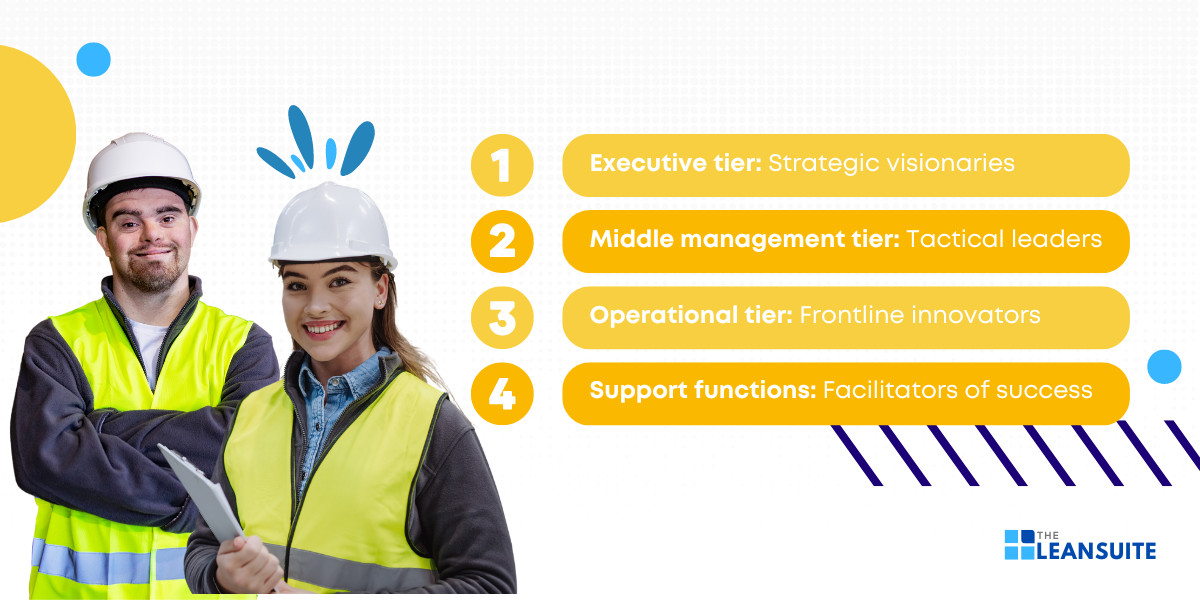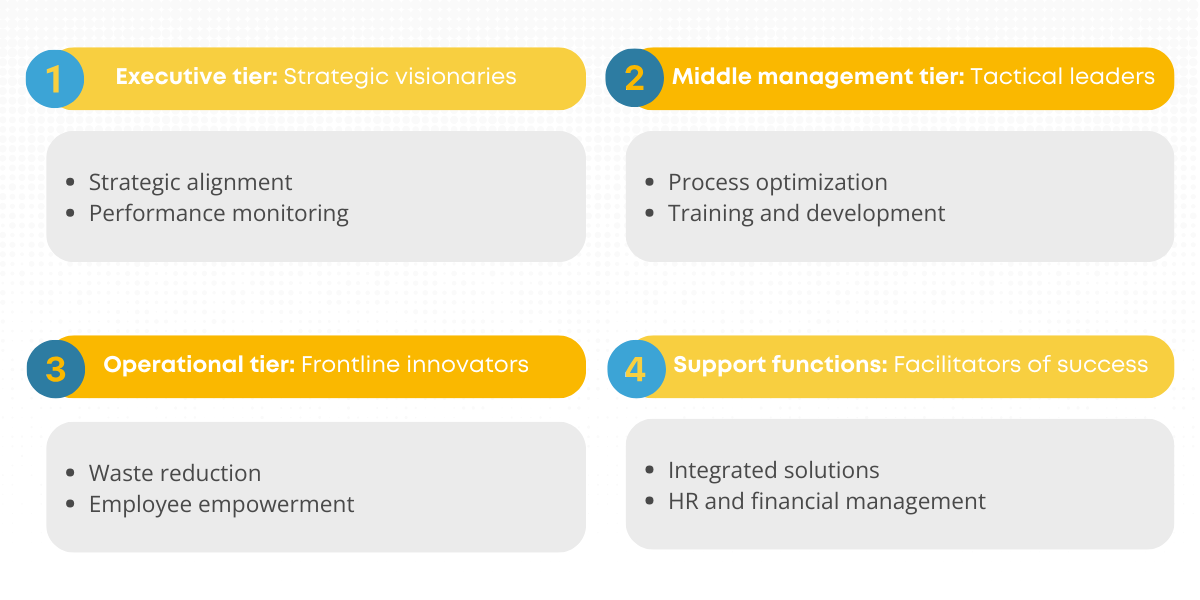Success in the manufacturing industry relies on the seamless integration of efforts across various tiers of an organization. From strategic leaders to operational teams, each tier plays a unique and crucial role in driving production efficiency and fostering innovation. However, optimizing these roles for maximum impact requires tailored solutions that align with the specific needs and objectives of each tier. LeanSuite, a comprehensive Lean Enablement Software, offers solutions designed to optimize every level of this intricate hierarchy. Thus, ensuring that all components work in harmony to enhance collaboration, efficiency, and scalability across all levels of a manufacturing company. In this blog post, we will explore how LeanSuite can optimize every tier in manufacturing, ensuring your manufacturing processes are as streamlined and effective as possible.
Understanding the role of each tier in manufacturing
We will now explore the critical roles played by different tiers within the manufacturing industry, unraveling how each contributes to the overall success of your organization.
The four key tiers we will explore are:

- Executive tier: Strategic visionaries – These leaders set the long-term direction and goals for the company.
- Middle management tier: Tactical leaders – They bridge the gap between strategy and execution. This ensures plans are effectively implemented.
- Operational tier: Frontline innovators – These individuals directly engage with the production processes, driving innovation and efficiency.
- Support functions: Facilitators of success – They provide essential services and resources, enabling the other tiers to perform optimally.
1. Executive tier: Strategic visionaries
This first tier in manufacturing is made up of executives known as strategic visionaries. They play a crucial role in setting the strategic direction and long-term goals of your company. In other words, these executives are responsible for aligning your company’s vision with market demands, ensuring sustainable growth, and fostering a culture of innovation. Essentially, their focus is not only on immediate performance, but also on creating a roadmap for future success.
Navigating complex challenges such as resource allocation, competitive positioning, and regulatory compliance, these leaders must skillfully direct the company toward profitability and excellence. So, by anticipating market trends and making informed strategic decisions, they ensure your company remains agile and resilient in a constantly evolving industry landscape.
2. Middle management tier: Tactical leaders
The middle management tier is comprised of tactical leaders. They play an important role in organizations by serving as the bridge between strategic goals set by your executives and the operational execution carried out by your frontline employees.
Tactical leaders play a part in translating high-level visions into actionable plans, ensuring that the grand strategies created in the boardroom can be effectively implemented on the shop floor. What’s more, they oversee process improvements, manage resources, and ensure that their teams have the tools and support needed to achieve their objectives.
In short, this tier is critical in identifying opportunities for efficiency, managing cross-functional collaboration, and driving continuous improvement initiatives. Ultimately, their ability to navigate both strategic and operational aspects makes them indispensable in maintaining organizational coherence and momentum.
2. Middle management tier: Tactical leaders
The middle management tier is comprised of tactical leaders. They play an important role in organizations by serving as the bridge between strategic goals set by your executives and the operational execution carried out by your frontline employees.
Tactical leaders play a part in translating high-level visions into actionable plans. In essence, they ensure that the grand strategies created in the boardroom can be effectively implemented on the shop floor. What’s more, they oversee process improvements, manage resources, and ensure that their teams have the tools and support needed to achieve their objectives.
In short, this tier is critical in identifying opportunities for efficiency, managing cross-functional collaboration, and driving continuous improvement initiatives. Ultimately, their ability to navigate both strategic and operational aspects makes them indispensable in maintaining organizational coherence and momentum.
3. Operational tier: Frontline innovators
The operational team is the backbone of manufacturing companies, playing a crucial role in executing production processes and ensuring quality control. That is to say, these dedicated employees work directly with machinery, materials, and products, positioning them perfectly to identify inefficiencies and propose actionable solutions.
The frontline innovators’ hands-on experience and intimate knowledge of the production line make them essential for maintaining high production standards and consistently meeting customer expectations. By leveraging their insights and expertise, you can drive continuous improvement, enhance operational efficiency, and sustain a competitive advantage in the market.
4. Support functions: Facilitators of success
The support functions, also known as the facilitators of success, comprises essential departments such as Human Resources (HR), Information Technology (IT), and Finance.
These functions play pivotal roles in enabling core manufacturing operations by providing key support in various domains. HR ensures that your organization attracts, retains, and manages talent effectively, fostering a skilled and motivated workforce. IT integrates advanced technology solutions, ensuring seamless operations and enhancing productivity through innovative tools and systems. Meanwhile, Finance carefully plans and manages your company’s financial resources, ensuring that your production teams have the necessary budget and financial oversight to operate efficiently.
Collectively, these support functions create a strong foundation that empowers production teams to focus on their primary task—manufacturing high-quality products—without being burdened by additional challenges.
How LeanSuite can help you optimize every tier in manufacturing

1. Executive tier: Strategic visionaries
Strategic alignment
LeanSuite promotes strategic alignment by providing your executives with the tools and insights necessary to align Lean initiatives with your company’s overarching business objectives. By leveraging LeanSuite’s robust analytics and performance tracking capabilities, your executives can ensure that each improvement effort directly contributes to the long-term goals of your organization. This alignment not only enhances operational efficiency, but also fosters a culture of continuous improvement. Thus, ensuring sustainable growth and innovation.
Performance monitoring
LeanSuite empowers your executives by providing tools for performance monitoring through advanced analytics and intuitive dashboards. With LeanSuite, your executives can effortlessly track key performance indicators (KPIs) in real-time, gaining valuable insights into operational efficiency and market positioning. The platform’s sophisticated analytics enable these strategic visionaries to make data-driven decisions, ensuring that your company remains agile and responsive to market dynamics.
2. Middle management tier: Tactical leaders
Process optimization
LeanSuite is an invaluable asset for tactical leaders focused on process optimization. It equips them with powerful tools such as the Continuous Improvement System and features like Workload Management and Best Practices, which are essential for identifying bottlenecks and streamlining processes.
With the Continuous Improvement System, your leaders can foster a culture of continuous improvement by encouraging small, incremental changes that lead to significant operational enhancements. The Workload Management feature helps your leaders balance and allocate resources effectively. Consequently, this ensures that teams are neither overburdened nor under-utilized. Additionally, LeanSuite’s Best Practices feature allows your leaders to identify, create, and replicate successful strategies. Thereby, optimizing processes and eliminating inefficiencies.
Training and development
LeanSuite provides comprehensive training and development programs designed to equip your tactical leaders with the skills needed to lead their teams effectively and foster a culture of continuous improvement. The platform offers a variety of training resources, including e-learning modules and videos, quizzes, and best practice guides, all aimed at enhancing managerial competencies. By focusing on practical, actionable insights, LeanSuite ensures that your leaders can translate high-level strategic goals into operational success, drive efficiency, and promote cross-functional collaboration within their teams.
3. Operational tier: Frontline innovators
Waste reduction
LeanSuite empowers operational teams to significantly reduce waste and boost efficiency by providing a robust suite of Lean tools designed for seamless integration into your manufacturing processes.
With LeanSuite’s Issue Tracker, teams can swiftly identify and address problems in real-time, ensuring that no potential waste source goes unnoticed. Additionally, the Emergency Work Order (EWO), Safety Emergency Work Order (SEWO), and Quality Emergency Work Order (QEWO) systems streamline the process of resolving urgent issues, standardizing responses, and maintaining quality control, respectively.
Through these comprehensive tools, LeanSuite ensures that operational teams can effectively implement Lean principles, driving continuous improvement and operational excellence.
Employee empowerment
By empowering employees to identify and suggest opportunities for improvement through the Suggestion Platform, an Idea Management System within LeanSuite, the company fosters a culture of ownership and accountability. This system encourages frontline innovators to actively participate in the continuous improvement process, allowing them to leverage their hands-on experience and intimate knowledge of the production line. As a result, employees feel valued and engaged. Therefore, leading to higher morale and productivity.
4. Support functions: Facilitators of success
Integrated solutions
LeanSuite offers integration capabilities with existing IT systems, enabling seamless data flow and process automation across departments. By connecting with your current software infrastructure, LeanSuite ensures that information is effortlessly shared between HR, IT, Finance, and manufacturing operations. This integration minimizes manual data entry, reduces errors, and accelerates decision-making processes. Consequently, LeanSuite enhances overall efficiency. That is to say, it allows support functions to operate in harmony and empowers production teams to maintain their focus on delivering high-quality products.
HR and financial management
LeanSuite’s platform significantly enhances the capabilities of HR departments by providing tools for developing competency management systems. In essence, it allows your HR professionals to accurately assess and track employee skills. That is to say, it helps facilitate targeted training and development programs that align with your organization’s strategic goals. As a result, this ensures a highly skilled workforce that can adapt to evolving industry demands.
Additionally, LeanSuite supports your finance teams by offering comprehensive tracking of the financial impact of your Lean initiatives. It provides insightful analytics and reporting features that enable your finance professionals to quantify cost savings, monitor budget allocations, and evaluate the return on investment for Lean projects. This level of financial oversight ensures that Lean initiatives contribute positively to your company’s bottom line while maintaining financial stability.
Scaling success with LeanSuite
LeanSuite empowers manufacturing companies by tailoring solutions to the unique needs of each tier. Thus, enabling them to optimize performance and achieve scalability.
By focusing on the specific requirements of each level within the organization, LeanSuite ensures that its comprehensive approach to Lean transformation is effectively implemented throughout the entire production process. This meticulous attention to detail allows the platform to optimize every tier in manufacturing, from the shop floor to the executive suite, fostering a cohesive and efficient production environment.
As a result, every aspect of your organization contributes to the overall goal of a sustainable and high-performing manufacturing operation, ensuring long-term success and adaptability in a competitive market.
Conclusion
In today’s competitive manufacturing landscape, success is not just about producing high-quality products but doing so with efficiency, agility, and innovation.
LeanSuite provides the tools and frameworks necessary for each tier within your manufacturing company to excel, fostering a culture of continuous improvement and collaboration. By leveraging LeanSuite’s capabilities, you can unlock new levels of productivity, adaptability, and growth. What’s more, with LeanSuite, you can optimize every tier in manufacturing. Thereby, ensuring that your operations are not only streamlined, but also resilient and forward-thinking.
Embrace LeanSuite to drive your manufacturing processes to new heights, achieving excellence at every level.





